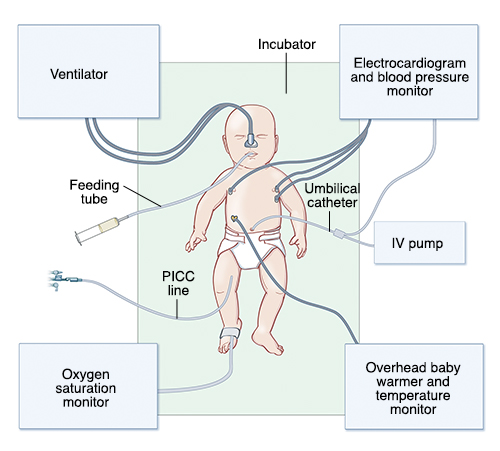Equipment You May See in the NICU
When your baby is in the NICU (neonatal intensive care unit), you will see them connected to thin, flexible tubes and wires. There are devices nearby that do important tasks. These are all helping your baby. Here is a guide to what you may see in the NICU:
-
Incubator. This is the clear plexiglass box that is your baby’s bed. This enclosed space protects your baby from temperature changes. A cloth cover can be placed over an incubator to keep out noise and light.
-
Radiant warmer. In some cases, this may be used instead of an incubator to keep your baby warm. It uses a warming device over the bed.
-
Cardiorespiratory monitor. This keeps track of your baby’s heartbeat and breathing. It’s attached to your baby’s skin with 3 leads (sensors). These are held in place with a gel that’s gentle to the skin.
-
Pulse oximeter. This measures the level of oxygen in your baby’s blood. This is called oxygen saturation. You may hear it called O2 sat. It’s attached to the skin with a sensor taped to your baby’s hand or foot. It works by shining a light into your baby’s hand or foot.
-
Blood pressure monitor. This may be a small version of the blood pressure cuff used on older children and adults. Or an arterial catheter may be used to keep track of blood pressure. This is a tiny tube inserted in an artery.
-
Temperature probe. This measures your baby’s body temperature. It’s attached to the skin surface.
-
IV (intravenous) line. This is a small, flexible tube (catheter) inserted into a vein. It’s used to give your baby fluids, nutrition, and medicines.
-
Umbilical arterial or venous catheter. This tube is placed in the artery or vein at the stump of the umbilical cord. It’s used to give your baby medicines, fluids, and nutrition. It’s also used to draw blood for lab tests. Because there are no pain nerves in the umbilical cord, this tube causes your baby no pain. But there is a higher risk of complications with an umbilical catheter than with an IV. Ask the nurse or doctor if you have questions or concerns.

Other things you may see
-
Feeding tube (gavage tube). This goes through your baby's mouth or nose and into their stomach. It's used to feed your baby milk or formula.
-
CPAP (continuous positive airway pressure) machine. This sends air or oxygen through tubes in the nostrils. It uses low, continuous pressure to keep the lungs inflated.
-
Endotracheal tube (ETT). This goes through your baby's mouth or nose into the windpipe. It's used with a respirator or ventilator to send air into the lungs.
-
Respirator or ventilator. These machines may be used to help your baby breathe. They are attached to an ETT.
-
Peripherally inserted central catheter (PICC) or a percutaneous central venous catheter (CVC). This tube may be inserted in a large central vein. It's used to give your baby fluids, nutrition, and medicine.
Online Medical Reviewer:
Donna Freeborn PhD CNM FNP
Online Medical Reviewer:
Heather M Trevino BSN RNC
Online Medical Reviewer:
Liora C Adler MD
Date Last Reviewed:
10/1/2022
© 2000-2024 The StayWell Company, LLC. All rights reserved. This information is not intended as a substitute for professional medical care. Always follow your healthcare professional's instructions.